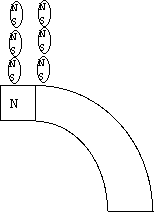
Black sand grains become magnets when they are near the pole of a radar magnet.
Notice that these grains attract each other vertically and repel each other horizontally.
Black Sand
Cover the magnets with black sand or washers and feel the amazing texture created when magnetic materials are near strong magnets. Build a bridge of sand or washers between the two magnets. Pass your hand through the bridge.
Black Sand Version
To Do and Notice
When you sprinkle black sand onto a magnet notice that the sand forms spikes and as more sand is sprinkled it adds to the ends of the spikes.
The spikes remain separated from each other.

Place your hand open and palm up over one of the magnets. Sprinkle black sand onto your hand, notice that it forms spikes. Move your hand back and forth and watch the spikes dance. Move your hand away from the magnets and notice how far away you can move before the sand is no longer affected by the magnets.
What's Going On?
When the grains of black sand are placed near a magnet they become magnets.
When placed near a north pole of a large magnet, the sand grains have a south pole nearest that north pole, and a north pole further away. These sand grains line up with their norths next to their neighbors souths and so make long columns or spikes. However, this arrangement of magnetic poles will repel the same arrangement placed to its side. Thus long columns of separated pikes are created.
Washer Version

To Do and Notice
Hold two washers a finger width away from one of the magnets. Touch the washers together, notice that they stick together when one washer is near the magnet and one is further away.
Hold the top washer and move both washers further and further away from the magnet notice that at some distance the bottom washer falls off the washer you are holding.
What's Going On?
The washers become magnets when they are near the large magnets in this exhibit. The washer-magnets then attract each other. When the washers are moved further from the magnets they lose magnetization and gravity pulls the lower washer away from the upper one.
To Do and Notice
Touch two washers together over one magnet. Notice that they stick together.
Move the pair of magnets across the gap between the two magnets. Notice that at some point the lower washer falls off the pair of washers and is attracted to the second magnet.
What's Going On?
If you hold a steel washer near the north pole of a magnet, the steel washer will become a magnet with the south pole of the washer near the north pole of the large magnet.
When you move a washer over to the south pole of the large magnet its magnetization must flip over so that the north pole of the washer is down toward the large magnet. As the magnetization of the washer flips over, it passes through zero. When the washers become demagnetized they fall apart.
Going further
Bring some steel nails to the exhibit. Place the nails in the palm of your hand over the magnet.
Touch one nail to the end of another and make a nail tower.
Touch a nail to a used paper clip some distance away from the magnets. Notice that the nail does not attract the paper clip. Touch the magnet with the nail, the nail then attracts the used staple. The nail has become magnetized, it is now a magnet.
Try to demagnetize the nail by vibrating it, slap it against a brick or hit it with a hammer.
Etc.
You can collect black sand if you live downstream from a mountain range with granite rocks. Turn a Ziploc bag inside out. Then place the largest magnet you can get inside the bag. Push the magnet through the sand at your local rivershore or beach. Black sand made of magnetite will be magnetically attracted. Turn the bag inside out once again and you have a clean magnet and a bag full of magnetic sand.
Etc.
A fraction of this magnetic sand is iron and comes from meteorites.
Etc.
Many versions of this exhibit use two "radar" magnets. These magnets were originally used in radar transmitters to generate microwaves. Electrons would orbit between the poles of the magnet to create the electromagnetic radiation.
|
Scientific Explorations with Paul Doherty |
|
13 June 2003 |